|
The
X organisation
is probably the area of undercover work that most people are
already
familiar with from escape stories. The
X
committee planned
escape
attempts, organised tunnel digging and devised other methods of exit
from
the camp.
The escape committee would usually try to
help any POW determined
to try an escape although it naturally gave most encouragement to,
those persons deemed to have the
best chance of success. For instance,
priority
might be given to persons fluent in
one of the European languages.
Next, there was 'Y'. That
section provided forgeries of maps, clothes and food, money and perhaps
a compass. It also organized a system of look-outs,
to protect the various undercover
activities.
Finally, there was the 'Z'
section. Activities included operation of the
camp's
secret radio. Probably most importantly, Z maintained contact with
the RAF intelligence section in
England by means of written codes.
All of the undercover work
will be described in considerably more detail, and to begin with, a
little more about the 'Z' section and its codes. In the earlier days of
the war, a few aircrew were given instruction in written codes in case
they were ever taken as prisoners-of-war. To improve
the obviously difficult security
aspect, such information was very
restricted, and it was suggested
that other aircrew might work out a code with their own family.
Fortunately, as things had turned
out, I had done that, having devised a code with my brother.
|
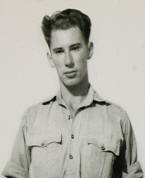 |
|
Tony Kilminster |
And this is the other half
of our private code team, my brother serving with the RAF in Africa in
1942. In the first letter that it was possible to write home, from
Stalag VIIIB, I was able to give my brother the details of how our
aircraft had been lost. The information was duly passed on to the
intelligence section of the RAF.
The vital part of secret
communication work, however, lay with the RAF codes. As soon as the 'Z'
section became organised at the new Stalag Luft I, it debriefed all new
POWs arriving in the camp, any useful items of
information being sent back to
England by coded POW mail. The information would be concerned mainly
with details of the loss of the new prisoner's aircraft so that,
provided a crew member was taken prisoner, the RAF would learn the
reason for the loss of that particular aircraft. Anything thought to be
of a military interest
that may have been noticed during a
prisoner's passage through Germany
would also be included.
Richard Drummond, one of
my fellow crew members and the second pilot of our ill fated Halifax.
Drummond had been one of the aircrew briefed in code work and, as a
prisoner-of-war, played a major role in the intelligence
gathering
and code transmission operations at Stalag Luft I.
|
 |
|
Richard Drummond |
Code work has received
little publicity compared to that of escape operations;
in fact; codes are not even
mentioned in the official RAF history of escaping from Germany. However,
with the 'Cold War' at its height
when the history was first
published, that is perhaps understandable. It is only comparatively
recently that I have heard some stories about that area of secret work
myself.
One of the more-remarkable
tales about secret codes. A POW camp received a request from England to
find out the thickness of the armour on the then
new
German Tiger tank. Their first reaction was 'How do they think we can
find
that out from a POW camp'? The story goes that they were able to do just
that. They contacted a Polish national brought into the camp for some
maintenance work; he, in turn, was able to contact the Polish
Underground Movement, that organisation had people actually working in
one of the factories that made the tanks.
Stalag Luft I
Returning now to Stalag
Luft I, in addition to establishing the secret communications link with
the intelligence section in England, undercover
work
in general was soon under way and, for the time being, we leave the 'Z'
,
section for some stories about the 'Y'
organisation.
It was of little use an
escaper succeeding in getting out of the camp if he didn't have suitable
documents. Apart from checks at most strategic points such as railway
stations and major bridges, police and the Gestapo often made spot
identity checks, particularly on any form of transport, and an escaper
not adequately prepared would have been unlikely to survive any such
check. In most cases, documents had to be forged.
FORGERY
|
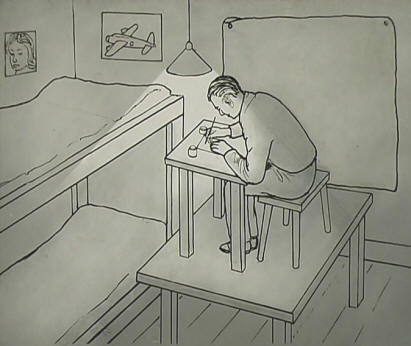 |
|
In the early days,
I only undertook forgery work after the huts (barracks) had been
locked and barred for the night; there was less chance of
interruption by German
security staff under those circumstances. To carry out the
forgery work,
a stool and something to serve as a small table were placed on
top of a larger table, so that the work could be brought as
close as possible under the none too bright electric light. A
blanket was draped over the window so that guards patrolling the
compound could not see through any chinks in the shutters that
were clamped across the windows at night. One of those earlier
types of forgery that has survived the years is described with
reference to the next two illustrations. |
| |
| Forged Identity Card
|

This is a forgery of a
German personal identity card, and it was the first
type
of forgery that I produced for the fledgling escape committee at
the new Stalag Luft I. It was actually copied from another
forgery that, to get us started, had been brought by the
volunteer group from Sagan when Stalag Luft I was reopened.
|
| |
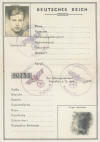
The inside
of
the forgery. To begin with, these
forgeries were produced entirely by hand drawing. The example
here is one of our later editions, although still mainly drawn
by hand, the police stamps had proved difficult to fake
convincingly by hand painting and in this instance were added by
a
duplicating
process, a method described
later. The hand drawn parts of the forgeries
were produced using a brush and Indian ink. Fortunately, some
months before becoming the forger for Stalag Luft I, I had asked
for some art materials to be included in any parcel that could
be sent to me. Prisoners on both sides in the war were able to
receive a small number of personal parcels through the
International Red Cross. |
|
As just mentioned,
there were problems trying to imitate rubber stamps
convincingly.
In addition to hand painting, I had tried several ways of
getting
a more-realistic result.
This is one of the earlier efforts, it is
a
stamp
made by etching aluminum
with acid: the aluminum was cut from a camp cooking
utensil. One difficulty lay
in finding a suitable substance to act as an acid resist for the
design. Eventually, some cellulose paint was obtained from the
camp theatre
group and that proved reasonably
successful. After drawing the design on the aluminum with the
cellulose paint,
the background was etched down using hydrochloric acid, a
substance the camp
authorities had supplied to clean
the latrine. Metal Stamp

Metal Stamp |
|
SECURITY
Most POW
undercover activities had to take place virtually under the
noses of the roving
German security staff and to
protect that work, all huts had a 'Duty Look-out'. If a guard or
other suspect approached a hut, the look-out gave a shout of
'Goon Up'. All illegal activities would then cease and any
incriminating items would be hidden. The term 'Goon'
puzzled the guards
at first,
although they were pretty sure that is was uncomplimentary.
|
|
ARTS & CRAFTS
In between forgery
sessions, I was trying to teach myself the techniques
of
oil and water-colour painting. Although I made little real
progress and I haven't attempted any painting of that sort from
that day to this, those efforts
did have a use, and two paintings that have survived are
included here
to visually complement an aspect of the forgery story.
 An oil painting of one of my
room-mates. however, to the story. During the longer days of
summer there was so little time between the huts being locked
and barred for the night, and lights out, that forgery work
necessarily had to proceed during open hours. To avoid having to
securely hide forgeries being worked upon every time German
personnel entered the hut, and that usually happened many times
during the course of a day, upon the shout of 'Goon up' from the
look-out, an unfinished painting was pinned over the top of the
forgery and I just carried on with the painting.
An oil painting of one of my
room-mates. however, to the story. During the longer days of
summer there was so little time between the huts being locked
and barred for the night, and lights out, that forgery work
necessarily had to proceed during open hours. To avoid having to
securely hide forgeries being worked upon every time German
personnel entered the hut, and that usually happened many times
during the course of a day, upon the shout of 'Goon up' from the
look-out, an unfinished painting was pinned over the top of the
forgery and I just carried on with the painting.
|
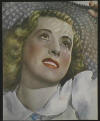
A water-colour that took its
turn in that procedure. Perhaps understandably, with a forgery
hidden underneath a painting, I became increasingly
uncomfortable if any German displayed more than a passing
interest in what I was doing. Some of the regulars must have
wondered why it was taking me so long to make progress on a
particular painting. |
|

On a somewhat similar theme, a POW arts and crafts exhibition, a
time when kriegie talents were put to more-legitimate use. Even
so, the abwehr, the
German security section,
must have been very intrigued, to say the least, by these
displays of kriegie work; many of the models required the use of
files saws or drills to produce them, all such items being on
the strictly forbidden list of course.
|
|
CONTRABAND
Whilst most
illegal articles were acquired by bribing or sometimes even
blackmailing a guard,
some items were almost impossible
to obtain in that way. However, some contraband was obtained
from England by being sent in
personal
parcels. Although all parcels were supposed to be opened and
checked by the camp security
staff, POWs were used as labour to unload the parcels from
railway trucks onto camp wagons, and to unload the wagons
again
at the camp. Parcels containing contraband would carry some
prearranged
distinguishing mark, and the attention of the guards could
usually be distracted for the brief moment necessary to
sidetrack a marked parcel. A number of items useful for the
camp's undercover activities were obtained by
means of the parcels route.

In my own area of
work, contraband material acquired by marked parcel included
this Kodak camera, it came complete with a supply of film and
photographic
processing chemicals.
|
|
OTHER AIDS TO
ESCAPE
European Money

In addition to
forged papers, money for European countries was an important
item for intending escapers and, in that context; there was an
amusing aspect
to an incident
at Stalag Luft VI. A marked parcel had slipped
through
their system without being spirited out in the intended manner
and, according
to regulations, was being
opened by German security staff in
front
of the designated recipient.
The parcel contained a box
full of European
money! The examiner stared in amazement; recovering, he rushed
to the
door of an office shouting to the security officer 'Come and see
what I've found'. His back was only turned for a matter of
seconds, but that was sufficient for several POWs waiting for
their parcels to grab a handful of money
and to stuff it into their
pockets. The examiner could see that some of the money had
vanished, but said nothing; he probably feared that he would be
on a disciplinary charge for having left the money unattended.
|
|
Compass
 Another
item sometimes useful was a compass. Being more enthusiastic at
the time rather than knowledgeable about the feasibility of
escaping, I had made my first compass in the early days at
Stalag VIIIB by magnetizing a razor blade. At that time we had
virtually nothing apart from the clothes
that
we wore. Occasionally though, we received a Red Cross parcel and
amongst
the 'goodies' was a tin of cigarettes. The top of the cigarette
tin was
sealed with a metal foil and, using a pair of nail scissors, the
foil was
cut into a long spiral, producing a sort of wire. That 'wire'
was insulated with paper and wrapped around the razor blade in a
coil. With an improvised fuse, the arrangement was connected
across the electricity
supply in a lamp holder,
there was a flash and a bang and the main electric cutout for
the hut was tripped, my fuse had been ineffective! Nevertheless,
and somewhat to my surprise, the razor blade had been
magnetized, and when suitably
pivoted
made a useable compass. Another
item sometimes useful was a compass. Being more enthusiastic at
the time rather than knowledgeable about the feasibility of
escaping, I had made my first compass in the early days at
Stalag VIIIB by magnetizing a razor blade. At that time we had
virtually nothing apart from the clothes
that
we wore. Occasionally though, we received a Red Cross parcel and
amongst
the 'goodies' was a tin of cigarettes. The top of the cigarette
tin was
sealed with a metal foil and, using a pair of nail scissors, the
foil was
cut into a long spiral, producing a sort of wire. That 'wire'
was insulated with paper and wrapped around the razor blade in a
coil. With an improvised fuse, the arrangement was connected
across the electricity
supply in a lamp holder,
there was a flash and a bang and the main electric cutout for
the hut was tripped, my fuse had been ineffective! Nevertheless,
and somewhat to my surprise, the razor blade had been
magnetized, and when suitably
pivoted
made a useable compass.
|
|
GETTING OUT
OF THE CAMP
Returning to the
topic of escaping, the most obvious problem was to find a way to
get out of the camp.

This photograph shows the outer fence at Stalag Luft I. In
addition to this
double fence, several yards further
in there was a warning wire, to step over that invited a shot
from one of the sentries in the guard towers. Nevertheless, a
number of prisoners did 'have a go' at the wire. Such operations
usually took place at night, but it was a 'dicey business' at
any time, several POWs were shot, or shot at, during such
attempts.
|
|

One of the guard towers or 'Goon boxes' as they were known by
POWs. Note the power and telephone lines, an aspect which
recalls one of the most audacious
individual escape attempts of the war. A POW at Sagan who spoke
fluent German disguised himself as a German camp electrician,
the ruse included
making a dummy electricians test meter. Borrowing a ladder and a
plank
from the camp theatre, the bogus electrician walked up to one of
the guard
towers and explained to the sentry that there was a fault on the
wires and that he had to test them.
Placing the ladder against the
inner fence, the POW climbed up and with the plank bridged the
gap between the inner and outer fences. He then pretended to
check the wiring.
At the far side of the fence he dropped his meter; swearing
profusely in German, he climbed down the outside of the wire,
retrieved the meter and, after examining it, explained to the
guard that it was damaged
and would have to be replaced. He then walked off through the
German part of the camp.
Even the exceptional nerve and initiative of this escaper was
finally unavailing,
he was recaptured at Stettin, a port on the Baltic, after five
days
on the run. However, the man was an inveterate escaper; he
managed to get
out of prison camps on several occasions. On what turned out to
be his last escapade,
which
makes a truly remarkable
story in itself, he finally
disappeared
without a trace.
Having a go at the wire was probably the most dangerous way of
trying to escape,
it took particularly intrepid individuals to take the chance.
There were other, inherently safer options. One reasonably safe
way of getting out of a prisoner-of-war camp was just to walk
out, through the gates! |
|
JUST WALK OUT THROUGH THE GATES
With a forged gate
pass and suitable clothing, persons fluent in German could pose
as a German civilian workman, or even a German guard! Such ruses
were tried on several occasions. |
 This
photograph shows parts of a dummy rifle used by a bogus guard at
Stalag Luft III in one of the most daring incidents of that
type. By using a forgery of a gate pass, the bogus guard
successfully marched a whole squad of prisoners out through both
the compound and the main gates of the
camp.
After marching some distance from the camp, the escapers
dispersed into the surrounding countryside. As happened all too
often, they were all eventually recaptured. Although we didn't
achieve anything so spectacular at Stalag Luft I, that tale from
Sagan helps to set the scene for some stories about our own
efforts at forging gate passes. This
photograph shows parts of a dummy rifle used by a bogus guard at
Stalag Luft III in one of the most daring incidents of that
type. By using a forgery of a gate pass, the bogus guard
successfully marched a whole squad of prisoners out through both
the compound and the main gates of the
camp.
After marching some distance from the camp, the escapers
dispersed into the surrounding countryside. As happened all too
often, they were all eventually recaptured. Although we didn't
achieve anything so spectacular at Stalag Luft I, that tale from
Sagan helps to set the scene for some stories about our own
efforts at forging gate passes.
|
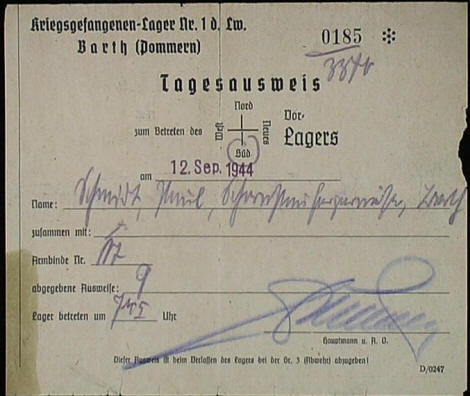 Genuine
Daily Gate Pass Genuine
Daily Gate Pass
This is a genuine daily gate pass that was used at Stalag Luft
I. To increase the security of this gate pass, the abwehr
changed the colour of the pass from day
to day in a random fashion.
|
|
 Forged
Daily Gate Pass Forged
Daily Gate Pass
This is a forgery of the daily gate pass, it was copied from a
genuine pass bribed out of one of the camp guards. Although I
drew several of these daily
gate passes, this particular
copy was drawn by an American prisoner-of-war. During the last
year or so of the war American airmen increasingly made up the
majority of the POWs at Stalag Luft I, and we naturally shared
our experience in escape and forgery work with them.
|
|

Camp Guards
A group
of German guards with their officers at Stalag Luft I.
According to the feedback of information that we were able to
obtain from some of the more amenable guards, our forgeries were
so good in general that the gate guards, when they were
questioned by their security officer, were unable to tell the
difference between a genuine gate pass and one of our forgeries
that had fallen into the hands of the abwehr.
|
|

Back of Daily Gate Pass
Shortly
after one of our forgeries
had fallen into the hands of the German security staff, this
intricate pattern was printed on the back of the pass to make
forgery more difficult, if not almost impossible
|
|
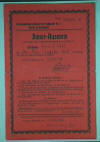 Monthly
Gate Pass Monthly
Gate Pass
The problem with a
daily gate pass was that, once it was dated, it was of no
further use if a planned escape attempt had to be postponed for
any
reason to another day.
However, the escape organisation achieved a major success in
acquiring an example
of the genuine monthly gate pass shown here. This was the most
useful gate pass because it was valid for a whole month. Being
so important, it was also correspondingly difficult item to
obtain but, eventually, sufficient pressure was applied to one
of the camp guards to persuade him to loan us his pass.
The guard slipped
the pass through a window of the hut at night when he was on compound
patrol duty. The only method of making a record of a pass at the
time was by hand tracing, and that took several hours.
We only just managed to
return the pass to the guard before his patrol duty ended. The
poor chap must have been on tenterhooks during the intervening
period in case we double-crossed him by keeping his pass. Using
the tracing as a
guide,
a forgery was produced by hand drawing. To my disappointment
after so much hard work, that forgery fell into the hands of the
abwehr at some stage
during the subsequent escape attempt. And it soon became
apparent, through our usual feed-back channels, that I had made
an unforeseen blunder in producing
the forgery.
My forgery would
have been geometrically identical to the original pass from
which it had been traced, but no two original passes would be
identical, with regard to the positions of such individual
additions as date stamps and the signature. The abwehr, just by
recalling all passes issued to the
guards and comparing the
positions of stamps and the signature with those on the forgery,
were able to match the forgery back to the original pass from
which it had been traced. The unfortunate guard who had been
persuaded to loan us his pass eventually received a considerable
prison sentence. Subsequently, we made sure that the positions
of stamps and the signature on a forgery were different from
their position on the original document. |
|
 Back
of Monthly Gate Pass Back
of Monthly Gate Pass
The abwehr,
probably
surprised that we could even
obtain, let alone forge such a difficult and strategically
useful item, responded in their usual way by having an intricate
design printed on the back of the pass. I never attempted to
draw this design by hand, looking at it, you can probably
appreciate why.
|
|
|
|
HIDING FORGEIES

Having produced a
forgery, it needed to be securely hidden until the time of use.
This photograph shows one method of hiding documents. It is a
book opened near its centre, the page binding cut through and
the laminations of a cover board largely slit apart. For
illustration, the cover laminations here are being forcibly held
apart. A forgery could be inserted in this gap between the
boards of the cover, the edges of the cover resealed and finally
the back edge of the pages glued together.
|
|
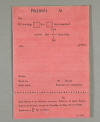
A continual
problem with forging lay in finding paper to make a reasonable
match to the genuine document. With this forgery of another type
of gate pass, it was impossible to find red paper of a shade
near enough to the genuine article. Because of that problem, I
eventually had to draw the pass
on white paper and then
colour it by spraying with water-colour paint using an improvised
sprayer.
|
|
 Enlarged
View of Perforations on Gate Pass Enlarged
View of Perforations on Gate Pass
The perforations
for the counterfoil at the bottom of the pass were knocked out
one at a time. To meet the requirements of an escape attempt
that might be arranged at short notice, we tried to keep a stock
of the most useful forgeries. With stock documents, such as this
gate pass, Serial
numbers were left off the forgery to start with: we could then
insert a serial number near to those current at the time the
pass might eventually be used.
|
|
THROUGH THE
GATE
Despite the
technical progress made in forging gate passes, and although
escaping from the camp through the gate was tried on several
occasions, it was, after all, a rather limited option. To have a
reasonable chance of getting through the gates, in addition to a
forgery of the relevant gate pass, it required someone with
considerable fluency in German. Most wouldbe escapers
needed a more widely available option, for instance - a tunnel.
TUNNELS
Tunnels always
seemed to offer the best prospects for getting out of a
prisoner-of-war camp, particularly for the escape of a large
number of people. During the course of the war at Stalag Luft
alone, what now appears to be the surprising figure of about a
hundred tunnels were dug or, more usually,
partly
dug before being discovered by the
abwehr.
|
|

Apart from not requiring fluency in German, tunnels also
promised a reasonably safe means of exit from the camp. A
successful tunnel was what
most people who wanted 'to
have a go' at an escape were waiting for. This cartoon depicts
what you might call 'Lines of communication', to warn of
approaching Germans when a tunnel was being dug.
|
| |
|
 Work
on Tunnel 'Harry' Work
on Tunnel 'Harry'
Work at the face
of the most famous tunnel of the war, the 'Great Escape' tunnel
'Harry' at Sagan. This sketch is by F/L Kenyon, DFC, one of
those who succeeded in getting out of the camp during the 'Great
Escape'.
Perhaps one of the
most inconceivable types of tunnel used the technique known as 'Moling'.
It is now difficult to believe that this bizarre method was
feasible at all, let alone actually tried on several occasions.
Definitely not for claustrophobics, the operation'
started by digging a hole
from a vantage point as near to the outer fence as it was
possible to get. The would be escaper was then actually sealed
into the beginning of a tunnel - and this is the almost
unbelievable aspect, with only holes made by something like a
broom handle pushed up through the surface of the ground to
obtain air. The procedure then, was for the tunneller to dig
forward, moving the soil behind him all the time and, as
necessary, pushing the broom handle up through the surface to
obtain air. The soil was light and sandy at both Sagan and
Barth, otherwise the procedure must surely have been
quite
impossible.
|
|

To combat
tunnelling activities, the abwehr deployed microphonic
detectors. Those detectors were buried about four feet deep and
spaced about twenty yards apart around the outer fence. They
were even placed around the exercise compound shown in this
photograph. The detectors proved to be a major problem at Stalag
Luft I, mainly because the water table was so near to the
surface that it was impossible to dig deep enough to get out of
their
range. By contrast, the tunnels for the 'Great Escape' at Sagan
had gone down 28 feet. However, one rather remarkable coup was
pulled off at Stalag Luft I with regard to the tunnel detectors.
From right under the noses of the camp guards, POWs were able to
dig up one of the detectors. We were then able to examine it at
leisure. That quite tricky operation was able to take place due
to the following circumstance.
|
|

As the war
progressed, the Germans needed to enlarge POW camps. That was
usually achieved by adding three sides of a new compound
directly onto the previous perimeter. In one such instance, the
original detectors, which as
a result of the procedure
were then inside the new compound, were not immediately removed
by the abwehr. The escape organisation promptly made
plans
to try to retrieve a detector to see if there might be any way
of combating them. The detectors were inside a new compound for
American prisoners and, with their co-operation, a mock auction
was held to attract a large number of people to screen the
operation from the guards in the overlooking watch towers. A few
POWs went feverishly to work and dug up one of the tunnel
detectors and, as the exceptional crowd was bound to arouse some
suspicion, hurriedly smuggled it away,
just before a guard arrived
on the scene. |
|
 Tunnel
Detector Tunnel
Detector
This drawing of
the tunnel detector was made at the time to provide a technical
record, as we expected intensive searches by the abwehr to
recover their hijacked property. We might also assume that
someone in the abwehr department had his wrist slapped over that
surprising oversight of not removing the detectors prior to
letting prisoners into the compound.
|
|
 Entrance
Shaft to 'Harry' Entrance
Shaft to 'Harry'
When tunnels were
being dug, the escape organisation sometimes made a levy on bed
boards to shore-up the roof of the tunnel. This photograph,
taken by the Germans, shows the entrance shaft for the 'Great
Escape' tunnel Harry at Stalag
Luft III, in this instance,
completely lined with bed
boards.
|
|

When tunnels using
bed boards were discovered, the camp administration would
sometimes retaliate,
by making their own levy, to bring
the prisoners' bed boards down to what they thought would be a
very uncomfortable minimum. Most people eventually became
extremely low on bed boards and the escape committee was not
always looked upon too kindly.
Leaving tunnels
for the time being, there were other ways of trying to get out
of a POW camp of course. Hiding amongst the piles of rubbish in
refuse carts was one useful, if smelly idea; that is, until the
Guards routinely prodded the contents of the carts with bayonets
as they went out through the gates of the camp. Not
surprisingly, that method lost its attraction. Once outside the
wire, by whatever means, it was essential that an escaper's
papers were appropriate to the disguise and nationality adopted,
and the escape organisation took every opportunity to acquire
genuine documents that could be copied for use in future escape
attempts. A forgery of one such document, a Polish identity
card, is shown in the next illustration. |
|
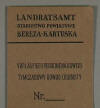 Polish
Identity Card Polish
Identity Card
Although
other European nationals brought into the camp were always
escorted by a German guard, it was sometimes possible for a POW
who spoke the necessary language to make contact with the person
being escorted. Contact was made by entertaining or bribing the
guard sufficiently to temper
his enthusiasm for duty. 'Entertainment' could be just an
invitation for the guard to come into a hut and partake of a mug
of real coffee, from Red Cross food parcels, and virtually
unobtainable in wartime Germany. Meanwhile, the guards charge
was being contacted by a POW. There were quite a number of
Polish nationals in the RAF, several eventually becoming POWs:
enabling us to make contact in this instance. This forgery was
copied from a genuine
Polish pass obtained by methods similar to those described.
|
|
DUPLICATING
 Inside
of the Polish Pass Inside
of the Polish Pass
The inside of the
Polish identity card, directly hand drawn except
for the stamp,
which was added by our duplicating
process.
|
|
 Enlarged
view of stamp on the pass Enlarged
view of stamp on the pass
The duplicated
stamp. We had acquired a simple duplicator quite early on but,
being bulky, it was difficult to hide and was found by the
abwehr during one of their searches. In that type of duplicator
a special ink was
used to draw the image to be
duplicated. Fortunately, the special inks vital to the process
were not found by the abwehr during their search and, after some
experiment, the rather unlikely substance of ordinary table
jelly was used as the ink transfer medium in an improvised
duplicator. The jelly was set to a stiff consistency in a
shallow tray,
and came from special Red Cross
food parcels intended for use in the camp's sick bay.
|
|
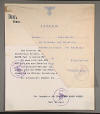
Jelly duplicating
was also of service in imitating
duplicated or even typewritten documents. To forge such
documents, the typewriter characters were imitated with a pen.
Ten or even twenty copies could be taken, partly dependent upon
how well the jelly surface stood up to the wear involved. These
two documents are travel permits, they are not very good
examples of that type
of work, but are the only copies that have survived.
|
|
ABWEHR SEARCHES
Snap searches of
the barrack huts by the abwehr were a regular feature of POW
life. Until we gathered experience, several items of contraband
were lost during such searches, including some of my forgeries
that I had hidden in tins buried underneath the huts. It became
a continual game of 'cat and mouse' between the abwehr and the
undercover organisations. Members of the abwehr staff, known by
the POWs as Ferrets, were also continually on the prowl, looking
for any signs of tunnel digging or other illegal activities.
What the abwehr was really after in the artistic line of course,
was evidence of forging.
|
|
 Duplicated
Stamps Duplicated
Stamps
The
duplicating process had finally given us an authentic looking
rendition of rubber stamps, and it proved to be quite a step
forward in the forgery business. The stamp was drawn on paper,
using the duplicating ink, then added to a forgery by jelly
transfer. These two stamps were on the back of a pass that
became one of our stock items.
|
|
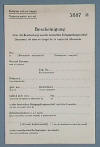 Pass
for a French POW Pass
for a French POW
This illustration
shows the front of that forgery, and it is the last of our
hand-drawn forgeries to be described. As a number of POWs could
speak some French, this was one of the more-useful items. The
forgery was copied from a pass borrowed from a French soldier
who had been taken as a prisoner-of-war and then forced to work
in Germany. The Frenchman had been escorted into the camp by a
guard and, in the usual way, a prisoner fluent in French was
able to make contact and persuaded the Frenchman to loan us his
pass.
|
|
 Enlarged
View of Above Pass Enlarged
View of Above Pass
Much of the
lettering on this pass was very small, and trying to copy it in
the time available was made more difficult by having to break
off work several times during the day when our lookouts deemed
that a German was getting too close to the scene of operations.
Fortunately, a reasonable copy was produced by the time the
original pass had to be returned to its owner.
|
|
PHOTOGRAPHY

Acquiring this
camera by means of the personal parcels route, as described
earlier, was of considerable help in the forgery business. Not
only did it enable a record of an original document to be made
in a relatively short time, it was an essential for producing
acceptable identity photographs for inclusion in forgeries of
identity cards.
|
|

To use the camera to full
advantage, various pieces of ancillary equipment were
constructed. This photograph shows the camera when adapted to
copy documents. The arrangement included an extension bellows
made from brown paper; we could then photograph an original
document at any size we wished up to full size. To vary the
reproduction size, the camera was moved along wooden rails.
There was also a sliding copyboard to facilitate positioning of
the original document; and for illumination, a lamp in a
reflector made from a dried-milk tin. Using this relatively
elaborate set-up, with the ever-present possibility of the
abwehr rushing in was, to say the least, rather an anxious
business.
|
|
 Back
of Monthly Gate Pass Back
of Monthly Gate Pass
To indicate how
useful the camera arrangement just described could be, this
illustration shows a print made from a negative that I produced
at Stalag Luft I in 1944, when the escape committee obtained
another example of the monthly gate pass.
Previously, the
only method of making a record of this pattern would have been
to try to copy it by hand tracing.
|
|
 Forged
Pass by Photography Forged
Pass by Photography
In one instance
the camera was used to produce a fake pass, saving many
hours of drawing with a
brush. That ausweis, shown here, is also an example of a
document that was just invented to suit a particular escape
attempt.
The wording was
devised by a POW fluent in German. To make up the pass, the
individual words were cut from a German magazine and pasted-up
to give the required format. The paste-up was then photographed
with the camera arrangement just described. The authorising
stamps were added to the final photographic print by jelly
transfer.
|
|
HIDING
PHOTOGRAPHIC
EQUIPMENT

Camera Set-up
This photographic
set-up was made so that it could be easily dismantled. Many of
the individual pieces then gave no indication of their ultimate
purpose and could be left in view with little danger of being
confiscated. That situation was aided by the fact that many POWs
made weird and wonderful gadgets from any odd pieces of wood or
metal that they could find.
|
|

Camera in brick
Across the middle
of the barrack hut there was a brick fire-wall, a brick was
removed from the fire wall in the loft area where it was quite
dark and a wooden box was constructed to the same size as the
brick; that box was just large enough to take the folded camera.
The box was fitted back into the fire wall and a slice of brick
was fixed to each end of the box to match the rest of the wall.
One of the slices of brick was removable, being fixed
with-counter-sunk
screws. The top of the screw holes were then filled with a
paste, made of chewed, German 'black' bread, that made a
reasonably
good match to the texture of the
brickwork, and it could easily be removed and replaced whenever
the camera was to be used. That hiding place was almost
impossible for the abwehr to discover. Nevertheless, had we been
caught in a snap search raid while the camera set-up was
actually in use, we would probably have been in considerable
trouble. As it was, the camera served us well until the end of
the war.
|
|
RETURN TO 'Z'
Leaving
photographic work, we come to our last major area of undercover
activity. The subject of the next illustration, apart from
providing a lead-in to the story, has quite a dramatic relevance
a little later on.
 The 7th of June 1944 and one of the few occasions when a German
newspaper was eagerly received by POWs. The Deutsche Allgemeine
Zeitung announcing the Allied invasion of Europe. Actually, we
sometimes knew more about what was going on than the German
public, and that remark heralds a return to the 'Z' section, and
the story of the Stalag Luft I radio. The 7th of June 1944 and one of the few occasions when a German
newspaper was eagerly received by POWs. The Deutsche Allgemeine
Zeitung announcing the Allied invasion of Europe. Actually, we
sometimes knew more about what was going on than the German
public, and that remark heralds a return to the 'Z' section, and
the story of the Stalag Luft I radio.
|
|
THE SECRET RADIO
The radio was
constructed by one of my room-mates, W/O Leslie Hurrell.
Although the major components would have been acquired in the
usual way by
bribing or blackmailing guards,
building a working radio under the conditions that appertained
in a POW camp would have required considerable improvisation and
ingenuity. Finding our radio ultimately became one of
the prime
objectives of abwehr searches. As the radio was relatively
bulky, hiding it securely whilst still being able to use it
easily, had presented some major problems. The eventual solution
is described with reference to the following few photographs.
|
|
 The
Radio The
Radio
This illustration
shows a board pried from the inner wall of the hut with the
radio fixed to the back of the board. As can be seen from the
photograph the radio was a two valve job.
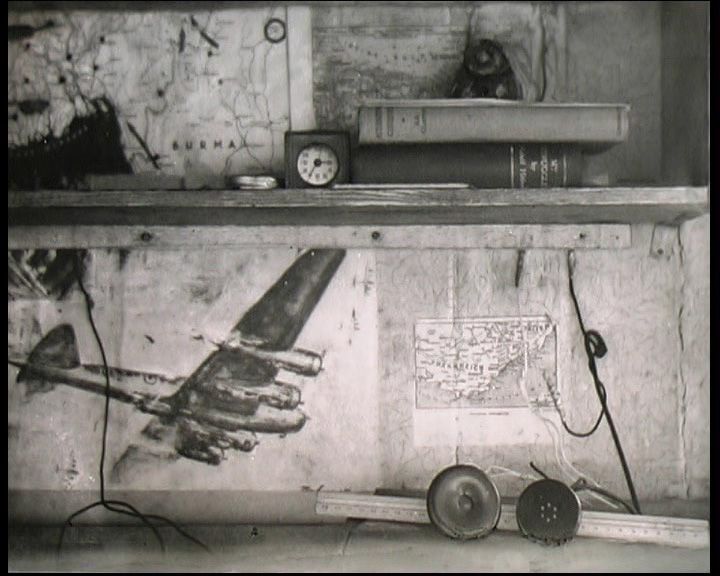
The wallboard with the radio on the
back has been put in place, pictures and maps from German
newspapers have been pasted over the joins of the wallboards, my
bunk-bed has been pushed back into position against the wall and
a book-shelf fixed over the critical position. To make contact
with the radio, wires were pushed through holes in the wall
boards. Those holes were positioned as inconspicuously as
possible and normally filled with plugs made to match the rest
of the wall. This photograph shows the radio ready to be used.
The batteries to operate the radio are on top of the books on
the bookshelf, the earphones are resting on the blanket of my
bunk-bed.
|
|
 To
tune-in the radio stations it was necessary to adjust the two
variable capacitors in the radio by means of screwdrivers also
pushed through holes in the wallboard. Unavoidably, those holes
were in a more-exposed position and, to camouflage them, the
holes were bored through one of the newspaper maps that had been
suitably positioned on the wall. To
tune-in the radio stations it was necessary to adjust the two
variable capacitors in the radio by means of screwdrivers also
pushed through holes in the wallboard. Unavoidably, those holes
were in a more-exposed position and, to camouflage them, the
holes were bored through one of the newspaper maps that had been
suitably positioned on the wall.
|
|
 Plugs
for those holes were then disguised to look like the towns that
were genuinely part of the map. Those plugs could be removed
with a pin when the radio
was to be used. For security, we chose a map of a remote
geographical area. On the left of this map of Burma,
screwdrivers can be seen inserted through our two fictitious
town. Even the most observant guards were unlikely to have
noticed anything strange about our alteration to the topography
of such a remote and little-known area. Plugs
for those holes were then disguised to look like the towns that
were genuinely part of the map. Those plugs could be removed
with a pin when the radio
was to be used. For security, we chose a map of a remote
geographical area. On the left of this map of Burma,
screwdrivers can be seen inserted through our two fictitious
town. Even the most observant guards were unlikely to have
noticed anything strange about our alteration to the topography
of such a remote and little-known area.
|
|
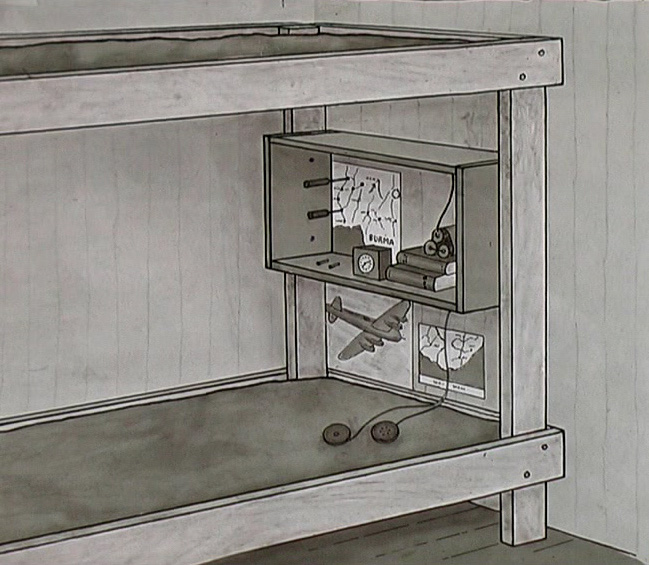
The location of
the hidden radio in relation to the bunk bed. Although the
system worked well, we didn't get away with it quite that
easily. The abwehr knew or suspected that we had a radio, and on
the night of the 6th June 1944 our luck finally ran out.
|
|
The 6th of June
was the day of the Allied invasion of Europe, and the abwehr had
no doubt assumed, correctly of course, that the
prisoners-of-war would be avid for news of that long-awaited
operation and must have thought that it would be an ideal time
to pounce and perhaps catch the radio operators in action. And
indeed, while the BBC midnight news, 1 am our time, was being
taken down from the radio, we were caught in a snap search raid!
Obviously timed to coincide with the most likely BBC news
broadcast, the abwehr mounted their largest night-time raid.
Choosing the critical moment,
twenty or so abwehr men rushed into the hut, several of them
entering each room almost simultaneously. Although we had the
usual duty lookout, there was only a few seconds warning.
Frantically, the
wires were removed and plugs reinserted in the wall. But there
was no time
to put the batteries and earphones into their normal secure
hiding places, they were just pushed under a bed, Virtually as
the guards burst into
the room. As it was my bed, it was my turn to be on tenterhooks.
In fact,
I found the strain so great as the abwehr started their search
that I walked out into the corridor, waiting for the shout of
triumph as the seemingly inevitable discovery was made.
To my surprise, and utter
relief, nothing happened! Apparently, my bed was the only one in
the room that the guards had not looked under! I can only assume
that, in the general confusion, each of the guards must have
thought that one of his partners had checked that particular
bed. After that almost unbelievable escape from disaster, the
radio survived safely until the end of the war, undetected in
many future searches. |
|
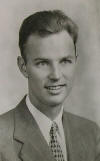
Under more-normal conditions, the BBC midnight news was taken
down on most
nights by Lieutenant Lou Trouve, a
POW from the American Army Airforce who was proficient in
shorthand, The notes were transcribed the next morning and then
read out in each hut. The written transcript was then destroyed.
This photograph of Lou Trouve was taken in 1946 after he had
returned to his profession as a journalist in New York.
Lou Trouve |
|

Lou Trouve also
played a part in another aspect of the undercover radio work at
Stalag Luft I. The radio program 'The Voice of America' often
included coded messages for American prisoners-of-war, some of
whom are seen here at Stalag Luft I. Again, those programs had
to be monitored in the middle of the night and taken down
verbatim in shorthand. The shorthand notes were transcribed the
next day to see if there were any messages relevant to Stalag
Luft I.
As the radio was hidden in the
wall at the foot of my bunk-bed, receiving the 'The Voice of
America' program at 2 am in the morning in addition to the BBC
news at 1 am, meant that I lost quite a lot of sleep during the
last year
or so of the war.
|
|
 Transceiver Transceiver
To bring the radio
story to a close, during the latter part of the war, and again
thanks to the personal parcels route for contraband, an American
combined radio transmitter and receiver was safely obtained at
Stalag Luft I. To smuggle an item of that size and weight
through the German security was quite a feat. Although the
radio was not necessary for our already established news
service, it did give the American contingent the opportunity to
set up a radio new service of their own. The transceiver also
offered a possible emergency link to the relieving forces in the
very uncertain and probably dangerous weeks expected at the
end of the war.
|
| The
radio operations are the last of the undercover activities to be
described in this record of secret work at Stalag Luft I, and to
round-off
the overall picture, part 3
continues the narrative with a few aspects of the camp's
eventual liberation, ending with an epilogue of half a century
later. |
|
